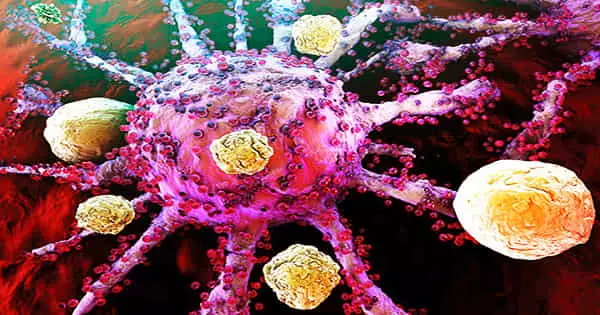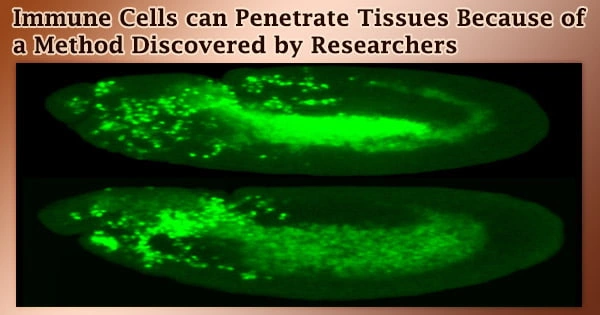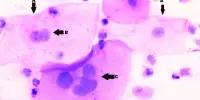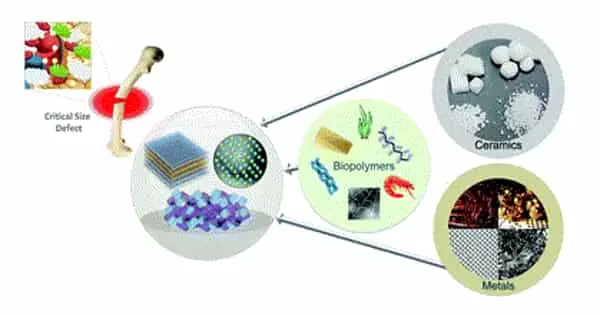Immune cells must enter tissue to fight infections and heal damage. They must also infiltrate tumors in order to combat them from within. Immune cells originate from bone marrow stem cells to become several types of white blood cells. Neutrophils, eosinophils, basophils, mast cells, monocytes, macrophages, dendritic cells, natural killer cells, and lymphocytes are some of the cells that make up the immune system (B cells and T cells).
B cells have two purposes: they present antigens to T cells and, more crucially, they create antibodies that neutralize pathogenic bacteria. Antibodies coat the pathogen’s surface and have three main functions: neutralization, opsonization, and complement activation.
Immune cells protect their sensitive insides as they squeeze between tissue cells, according to scientists from the Siekhaus group at the Institute of Science and Technology (IST) in Austria. The team’s study, which was published in the journal PLOS Biology, provides the groundwork for identifying novel cancer therapeutic targets.

It’s impossible to predict when immune cells may try to infiltrate a tumor. Scientists like Professor Daria Siekhaus and her team require something more trustworthy to research this cell invasion process in depth.
That is why fruit fly embryos are used. Macrophages, the fruit fly’s most common type of immune cell, go from where they are born to where they are needed by invading tissue during the development of these embryos.
Scientists may study the process within these tiny transparent animals since they do it at a specific moment. They watch as macrophages labeled with a green fluorescent protein force their way into the tissue with the help of IST Austria’s cutting-edge Bioimaging Facility.
Creating an armor
It’s still unclear which cellular modifications are required and which genes are responsible for these changes. The Siekhaus group sheds light on this mechanism, which is important in both health and sickness, with their new work by first authors Vera Belyaeva, Stephanie Wachner, and Attila Gyoergy.
“Previously, we found that a specific gene, called Dfos, is enriched in the immune cells and we wondered what it did,” says Siekhaus. “Now we can prove that it triggers the assembly of actin filaments.”
Previously, we found that a specific gene, called Dfos, is enriched in the immune cells and we wondered what it did. Now we can prove that it triggers the assembly of actin filaments. We hypothesize that this works like a tank, deforming surrounding cells while protecting the immune cell’s nucleus from mechanical pressure as it invades the tissue.
Daria Siekhaus
The interior of the cell membrane, also known as the cell cortex, is densely packed with protein threads that provide cell surface stability. The researchers reveal that actin filaments become denser and more coupled to one another as a result of a complex protein cascade, generating a stable shell.
“We hypothesize that this works like a tank, deforming surrounding cells while protecting the immune cell’s nucleus from mechanical pressure as it invades the tissue,” Siekhaus explains.
In addition, the researchers were able to demonstrate in vivo that the absence of this actin layer makes it difficult for immune cells to enter unless the surrounding tissue is softened.
Strengthening immune cells to fight cancer
Although a fruit fly and vertebrates such as mice and humans appear to have little in common at first appearance, their genes act in remarkably similar ways.
The researchers at IST Austria discovered evidence that the vertebrate gene Fos, which is identical to the fruit fly gene Dfos, activates the same genetic pathways as the fruit fly gene Dfos, working with Professor Maria Sibilia from the Medical University of Vienna.
“We think that the same mechanism we found in the fruit fly also plays a role in vertebrates,” says biologist Daria Siekhaus.
This raises the possibility that the group’s discoveries will aid in the identification of novel cancer therapeutic targets.
Researchers in the discipline of immuno-oncology are trying to figure out how to get the body’s immune system to attack a tumor. Allowing immune cells to enter the tumor is one of the obstacles they face.
“If one could strengthen their protective shell, it could make it easier for them to invade the tumor tissue,” Siekhaus concludes.
















